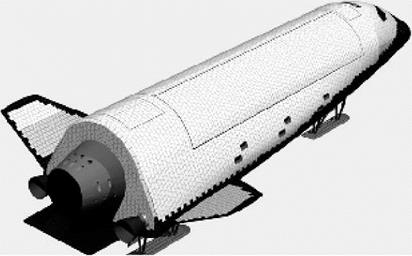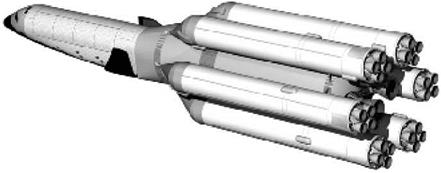The MTKVP lifting body
Called the Reusable Vertical Landing Transport Ship (MTKVP), the lifting body was a 34 m long vehicle consisting of three main sections: a front section with the crew cabin, a mid-section containing a huge payload bay, and an aft section with orbital maneuvering engines. After using its limited aerodynamic characteristics during the hypersonic stage of re-entry, the vehicle would deploy a series of parachutes at an
|
The MTKVP lifting body (source: www. buran. ru). |
|
The MTKVP sitting atop the RLA-130V launch vehicle (source: www. buran. ru). |
altitude of 12 km and a speed of 250 m/s. Vertical landing speed would be dampened with small soft-landing engines and horizontal speed with a ski landing gear.
One of the big advantages of this design was that the ship did not need expensive runways, although some of the plans did envisage landing on a prepared dirt surface. The absence of wings, which are dead weight for most of the flight anyway, also saved a lot of mass. The MTKVP would weigh 88 tons and have a payload capacity of 30 tons to a low 50.7° inclination orbit and a return capacity of 20 tons. Moreover, the MTKVP could rely on proven technologies such as other aerodynamically shaped objects (in particular, the Soyuz descent capsule and nuclear warheads) and parachute and soft-landing systems that had been used for some years by airborne troops to safely land heavy cargos. The idea also was to retrieve the RLA strap-on boosters in a similar fashion, leading to additional cost savings.
However, a major disadvantage of the MTKVP was its low cross-range capability. This was particularly important for the Russian orbiter, because unlike its American counterpart, it could land only on Soviet territory. At a later stage in the design process an attempt was made to improve the vehicle’s cross-range capability from about 800 km to 1,800 km by giving the fuselage a slightly triangular shape. Another problem was that a vehicle of this type would be exposed to extremely high temperatures (about 1,900°C), placing high demands on the heat shield and requiring long turnaround times for repair work. Many doubted if it would be reusable at all. Moreover, since the vehicle was supposed to land in the steppes, it would have been a cumbersome process to recover it and transport it back to the launch site.
The launch vehicle for the MTKVP was known as RLA-130V. It consisted of a 37.4m high core stage powered by two 250-ton thrust LOX/LH2 RD-0120 engines and six 25.7 m high strap-on rockets with 600-ton LOX/kerosene RD-123 engines [54].












